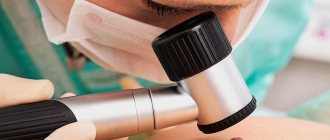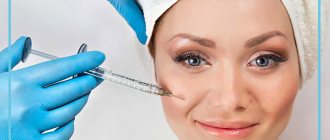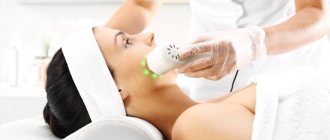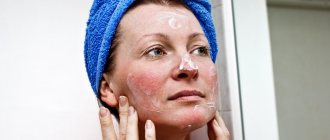If, after a wild party, you have red spots on your face and hives appear on your body, this may be an allergy to alcohol. And although this fact is surprising to many people, an allergic reaction to alcoholic beverages is a very common phenomenon.
Few people know, but...
According to some reports, 7% of people, or approximately one in fifteen, are allergic to alcohol.
A few more numbers: since school years we have known that a person consists of 70% water, but teachers do not tell us that we have... about 0.19 ‰ of endogenous alcohol.
Note to car enthusiasts
Prolonged oxygen starvation, chronic diseases of the kidneys, lungs and liver, central nervous system and diabetes mellitus can provoke an increase in endogenous ethyl alcohol in the blood!
Ethanol is formed in the cells of the body as a result of various biochemical reactions and in the intestines during the digestion of food. How can an allergy to alcohol occur to a substance that is present in our body almost “from the cradle”?
So, let's try to figure it out - is there an allergy to alcohol?
Internal ethyl alcohol is a compound necessary for metabolism and energy, which regulates the permeability of cell membranes and helps the body adapt to stressful situations. So can you be allergic to internal alcohol? In fact, no, because it is the “brainchild” of the organism itself.
More often, allergies occur from alcohol taken orally. Theoretically, such reactions of the body are possible to all types of alcoholic products.
It is difficult to say when the first alcoholic drink appeared, perhaps at the same time as the first dishes. Our distant ancestors created the first varieties of wine and beer from grapes, honey and fruits.
Pure alcohol was obtained by alchemists in the Middle Ages and was called “alcohol,” which means “intoxicating” in Arabic. Did you already have an allergy after drinking alcohol? History is silent about this, but modern alcoholic drinks quite often become the cause of allergies.
There are allergies to preservatives, dyes, hops, tannins, malt, flavorings, yeast, wort and other substances that are used in the production of alcoholic beverages. The most “allergenic drinks” are considered to be cognac, beer, liqueur, wine and vermouth.
It is safe to say that the cheaper the alcohol purchased, the higher the risk of an allergic reaction due to the large number of dangerous additives.
Substances used to protect plants from parasites and fertilizers for a better harvest, if they get into plants, can cause an allergy to alcohol.
Allergens from fruits and berries from which the alcoholic drink is made also cause symptoms in people with food allergies.
Attention!
The rapid removal of ethanol breakdown products from the body with the help of Enterosgel sorbent will help avoid allergies from alcohol and alcohol poisoning.
Many organic (and inorganic) substances can enter alcoholic beverages during the technological process. It is from them that signs of skin allergies and digestive disorders appear.
By the way…
Ethanol is a good solvent for various substances that, when entering the body, begin to manifest their “allergic essence”. In other words, ethanol increases allergies. Moreover, alcohol can be very dangerous if you have allergies!
Ethyl alcohol also accelerates the absorption of allergens that enter the body with various products. It has been established that ethanol contributes to the occurrence of nutritional allergies in 12% of patients. A red face, rashes on the legs, torso and arms after drinking alcohol are quite common manifestations among allergy sufferers.
In addition to alcoholic beverages, ethyl alcohol is included in various medicines, hygiene and cosmetic products - because of this, allergic reactions often occur to them.
Alcohol and pregnancy
Drinking alcoholic beverages by a pregnant woman in the future provokes allergic diseases in children - asthma, dermatitis, rhinitis, and so on.
Risk factors and groups
Most often it affects women and children. In men and people aged 50+, a perioral immune reaction is extremely rare. Young girls under 30 and young children are at particular risk.
The occurrence of allergies is provoked by the following factors:
- Hereditary predisposition. The presence of immune abnormalities is transmitted at the genetic level. A child who has a close relative with similar problems has a 50-70% risk of developing an allergy.
- Bad ecology. An increase in allergenic air levels provokes a rapid process of urbanization and industrial growth.
- Decreased immunity due to frequent recurrent or acute diseases.
- Infectious diseases and antibiotic therapy.
- Frequent stressful situations.
- Using low-quality cosmetics or incorrect selection of cosmetics.
- The presence of bad habits - alcohol abuse, smoking, overeating.
- Failure to comply with nutritional rules. This reason especially affects infants - untimely introduction of complementary feeding and supplementary feeding, incorrect choice of milk substitutes, as well as older children - consumption of fast food, out-of-season products, products with dangerous additives.
- Early termination of breastfeeding.
- Complications in the mother and fetus during pregnancy: gestosis, fetal hypoxia, premature birth, etc.
- Hormonal surges – adolescence, pregnancy, menopause, hormonal imbalance.
- Work in hazardous production.
- Immaturity of the immune and digestive system in children under 3-5 years of age.
- The presence of parasites in the body.
Types of allergies to alcohol
Hereditary predisposition plays a major role in the likelihood of any allergic reaction. A person whose parents have allergic diseases also becomes allergic in 80% of cases. This reaction of the body is called innate. By the way, intolerance to alcohol, as well as congenital allergy to alcoholic drinks, is more common among residents of Asian countries. Additionally, alcohol allergies are common in people with lactose intolerance.
A person “earns” an acquired allergy throughout his life as a result of exposure to external allergens (food, pollen, household dust, alcohol, etc.)
Perioral dermatitis in children
The first symptom of the onset of the disease in a child is a rash around the mouth. It may appear on the chin while eating and then disappear. When perioral dermatitis in children begins to progress, the redness becomes persistent. If the disease is not treated, the areas affected by dermatitis will turn blue. Dilated small vessels become visible. If a doctor diagnoses a child with this disease, you must:
- limit baby's contact with water;
- remove fatty, salty and sweet foods from the menu;
- Stop using cosmetics that are not certified by medical centers.
The disease occurs very rarely in children. It is provoked by hormonal changes in the body, the use of sprays or creams with glucocorticoids. During hormonal changes in newborns, the disease goes away within a month. If the rash is caused by the use of hormonal medications, then the treatment period, as in the case of adults, will be 3-4 months.
How does an allergy to alcohol manifest itself?
The more often an allergy is provoked, the more severely a person’s symptoms are tolerated each time.
Allergies on the face, neck, diarrhea, red spots on the body, burning in the mouth, swelling of the lips and tongue - this is how an allergy to alcohol manifests itself in most cases.
For people allergic to alcoholic drinks, drinking alcohol is undesirable: at one “wonderful” moment the body can react with life-threatening conditions - Quincke's edema or anaphylactic shock.
In the development of allergies, the key factor is the contact of the allergen (any substance in the air, food, clothing, etc.) with the body. Accordingly, minimizing or eliminating such contact prevents the development of the reaction, which explains the effectiveness of Enterosgel.
It is known that the intestines play a critical role in the functioning of the immune system. Enterosgel removes allergens from the gastrointestinal tract. In addition, Enterosgel removes bacterial endotoxin, promotes the regeneration of damaged mucosa and normalizes the intestinal microflora. Thus, the functioning of the intestines and immune system is restored, and allergic manifestations are reduced.
At the first signs of a possible allergy, you can take Enterosgel in a standard dose. Then use the drug according to the instructions for 1-2 weeks.
By the way…
If treatment with Enterosgel sorbent is started on time, severe anaphylaxis can be avoided.
An allergy to alcohol also manifests itself with other signs, not just redness on the face. In particular, after drinking alcohol the following may occur:
- suffocation;
- sweating;
- nasal congestion;
- stomach ache;
- headache;
- diarrhea;
- swelling of the neck, face;
- vomit;
- heartbeat;
- dry cough;
- skin itching;
- decrease in pressure.
Alcohol, like food allergens, plays a leading role in the development of chronic urticaria.
Most signs of allergy disappear after taking Enterosgel. Otherwise, medical attention is required!
Dermatitis on the chin
IMPORTANT!
In order to save the article to your bookmarks, press: CTRL + D DOCTOR, and you can get a FREE ANSWER by filling out a special form on OUR SITE, follow this link >>>
Treatment of perioral dermatitis on the face
The occurrence of various rashes and inflammations on the skin of the face almost always indicates the presence of some health problems. Perioral dermatitis is a rare disease that most often affects women and girls between the ages of twenty and forty.
What is the perioral region
The area around the mouth on the face, which includes the chin and perioral skin, is called the perioral region. The skin in this area is very often exposed to all sorts of irritations, resulting in acne or rashes. Such phenomena usually cause severe psychological discomfort, especially when it comes to young women.
What is perioral dermatitis
Oral dermatitis is a skin disease that occurs on the areas of the facial skin around the lips.
Most patients diagnosed with this disease are women of reproductive age, but in recent years this type of skin disease has been increasingly found in children.
Some experts consider this disease to be a form of seborrheic dermatitis, and it is also often called rosacea-like.
With this disease, small pockets of inflammation begin to appear on the chin and in the area near the mouth,
Perioral dermatitis - in medicine it is also called rosacea-like or perioral dermatitis. This is a rare disease, occurring in approximately 1% of the population, most often in women 20-40 years old.
With perioral dermatitis, small papules and pimples appear on the skin around the mouth and on the chin, the skin turns red, irritation appears and papules grow over a larger area. This creates considerable aesthetic, physical and psychological discomfort for a person.
Within a few months, the skin around the mouth and chin became simply red, and when the acne healed, it left dark spots. Moreover, between the lips and the affected areas around the mouth there is a clear strip of healthy skin without redness...”
Symptoms of perioral dermatitis
- Pain, itching, burning, redness, a feeling of tightness of the skin, and small red pimples appear in the area of the chin and mouth.
- Pimples may have heads that release clear liquid when emptied; over time, pimples become ulcers.
- Pimples form colonies, group clusters
- The skin in the inflamed areas begins to become covered with thin transparent scales, which then fall off
Most likely, this skin inflammation is caused by perioral dermatitis. But to clarify the diagnosis, you should definitely consult a dermatologist, since the appearance of acne and irritation on the face can be due to other reasons:
- Diffuse neurodermatitis
- Allergic contact dermatitis
- Seborrheic dermatitis
- Acne vulgaris, rosacea, steroid acne.
To isolate the microflora of the lesion site and determine the pathogen, a bacterial culture of the scraping or contents of the rash is carried out.
The skin around the mouth may not be changed and present a normally colored border of up to 2 cm. Usually, the rashes are located on slightly reddened skin or the skin does not change color.
Causes of perioral dermatitis
- Decreased humoral and cellular immunity
- Climate change, excessive exposure to ultraviolet radiation
- Increased sensitivity to bacterial allergens
- Long-term or even short-term use of topical corticosteroids in the form of creams, ointments (see a complete list of all hormonal creams and ointments - Psoriasis Ointments)
- Predisposition to allergic reactions, presence of allergic rhinitis, bronchial asthma
- Quite sensitive facial skin
- Excessive use of various facial cosmetics
- Hormonal imbalance in gynecological disorders
- Use of dentures, toothpastes containing fluoride
- Disorders of the gastrointestinal tract, nervous system, endocrine system
- Ointments, creams for dermatitis
- Creams and ointments for psoriasis
- Treatment of dermatitis on the hands
- Treatment of atopic dermatitis in adults
- How to treat eczema on hands
- Treatment of dyshidrotic eczema
- Allergy creams
- How to take antibiotics correctly
How to get rid of an allergy to alcohol?
The first step is to determine which alcoholic drink causes the allergy. Knowing the allergen, you can decide which drinks you can drink if you have allergies and which you cannot.
If a rash and redness appear on the face after drinking alcohol (whiskey, cognac), it means that the patient has an allergic reaction to tannins or fusel oils.
If the allergy appears after drinking beer, there is probably an intolerance to brewer's yeast or malt. Often such people have food allergies and drug allergies to penicillin.
What, even for beer?
Scientists say: approximately 1% of the world's population is allergic to beer, which is associated with the body's reaction to one of the proteins in barley.
During the fermentation process in wine and beer, histamine is formed - a substance that triggers allergic reactions in the body for all types of allergies, from pollen to contact allergies. Red wine contains even more histamine. Yes Yes! Unfortunately, wine contains not only the truth, but also a whole “bouquet” of allergens. Some of them are contained in raw materials, others end up in the drink during factory production.
Information for wine lovers
Allergic reactions to red wine are more common in people suffering from bronchial asthma and allergic rhinitis.
An allergy to grapes can cause anaphylaxis to grape wine. It has been scientifically proven that allergies to grape wine occur in people with latex allergies and allergies to grape pollen.
To clarify wine, substances with a high allergenic index are used - egg white, gelatin, milk casein and others, which pose a great danger to people with food allergies.
Proteins from insect venom and fungi that live on grape bunches can also become allergens. These substances enter the wine during pressing of grapes.
Sulfur dioxide, sulfites or other components of wine can cause an allergic reaction.
By the way, about sulfites: these substances are one of the main “provocateurs” of allergies to alcoholic beverages. It is known that high concentrations of sulfites are found in wine, beer and cider and can provoke an attack of bronchial asthma, Quincke's edema, and urticaria. In addition, they can be found in dried fruits, shrimp and almost all cosmetics.
Allergies to vermouth often occur in people suffering from hay fever, for example, with an allergy to wormwood or sunflower.
Almond liqueur and mulled wine are dangerous alcohol if you are allergic to almonds. With pollen and food allergies to barley, an allergy to beer may occur.
Champagne lovers may also experience an allergic reaction. The fact is that this sparkling drink, beloved by many, contains strong allergens: mold and yeast, as well as various additives: flavor enhancers, sweeteners, etc.
Whatever they mix!
A large number of additives are added to cheap alcohol: dyes, essences, thickeners - these are the ones that often cause allergies in adults and adolescents.
Oddly enough, it is even possible to have an allergy when drinking vodka, especially if it contains flavorings or dyes. Maybe you can “deal” with artisanal alcohol? Chacha, moonshine and mash can also hardly be called safe, so it’s better not to risk your health!
“But this is all here, but in Europe...”
According to European scientists, in 15% of cases it is alcohol that causes anaphylaxis, and most of the toxic effects of ethyl alcohol are associated with alcohol abuse.
Causes
An itchy chin can affect a man, woman, or child. It has been noted that the weaker sex is more susceptible to this problem due to the frequent use of various decorative and cosmetic products. But first things first.
In medicine, the most common reasons why the chin may itch are:
- Demodex mite. Infection can cause not only obsessive itching, but also other problems. In areas affected by mites, redness and peeling appear. There is a multiplicity of inflammatory elements characterized by a porous structure.
- Acne. If inflammatory processes occur in the sweat, sebaceous glands or hair follicles, itching in the chin area may occur. Very often it is internal deep pimples that cause severe itching.
- Development of eczema. Both weeping and dry eczema cause not only itching, but also provoke the appearance of peeling, the appearance of plaques, which have a red, inflamed rim.
- Excessive addiction to alcohol and smoking.
- Insufficient facial skin care.
- Some diseases, a symptom of which may be itching: blood diseases (including anemia), somatic disorders, type 2 diabetes mellitus, etc.
- Stress in the body that develops under the influence of various factors.
- Increased sensitivity or dry skin. Epithelial irritation can occur for various reasons. For example, it can be caused by chapping, frostbite, thermal, solar or chemical burns. This problem is quite common among men with sensitive skin. The razor blade damages the upper epithelial layer, which leads to severe irritation accompanied by itching.
- Herpes. Usually the formation of herpetic papules is preceded by itching. In addition, the skin in places where tumors appear begins to turn red.
- One of the most common causes of an itchy chin is an allergic reaction.
Regarding the last point, it is allergies that most often provoke discomfort, expressed in itching of the chin. Anything can be an allergen:
- medications;
- food and drinks;
- pet hair;
- home and industrial dust;
- pollen;
- insect and animal bites;
- ultraviolet rays, high and low ambient temperatures;
- cosmetical tools.
Women may be allergic to decorative cosmetics and skin care products. For example, when using foundation creams, lotions, or gels, the cause of the reaction may lie either in individual intolerance to individual components of the product or in their incorrect use. In particular, a woman does not always apply and remove, for example, foundation correctly, which causes the sebaceous or sweat glands to become clogged. Hence all the ensuing consequences.
Often, in the event of an allergic reaction, not only the chin begins to itch, but also the neck, cheeks, and forehead. Swelling of the epidermis, a burning sensation, areas of redness, and a rash may appear. In order not to wait for the condition to worsen, you need to respond to the problem as quickly as possible.
How to cure an allergy to alcohol?
First of all, you need to stop drinking alcoholic beverages and consult a doctor. You should not look for treatment on the World Wide Web, rely on the experience of a neighbor, or act at your own discretion. Therapy is selected individually for each person, especially for people with alcohol addiction.
If signs of allergy appear after drinking alcohol, it is necessary to induce vomiting and rinse the stomach.
It is worth having Enterosgel in your home medicine cabinet - a proven medicine for effectively removing allergens and toxic substances from the body, although some are accustomed to relying on pills for alcohol allergies. Antihistamines will also help.
In severe cases, doctors prescribe intravenous infusions of detoxification solutions. To improve liver function, hepatoprotectors are prescribed.
Remember:
When starting to treat allergies, it is important to remember that many medications are incompatible with alcohol, and they should be taken only after eliminating alcoholic beverages! Otherwise, if you have allergy symptoms, you may also get an unpredictable response from the body.
Fasting days will help to cope with intoxication of the body: fruit, kefir-milk, vegetable.
Chronic neurodermatitis and its treatment
Chronic neurodermatitis is a skin disease from the group of allergic dermatoses, the occurrence of which is based on allergic reactions and a disorder of nervous regulation. The main symptoms of the disease are skin itching and rashes.
Neurodermatitis is an external manifestation of the dysfunction of the immune and nervous systems, which are unable to adequately respond to external stimuli (penetration of antigens into the body). Immune reactions have increased “aggressiveness” and are directed at one’s own tissue structures.
The skin is mainly affected, in which, under the influence of antibodies, damage to collagen fibers and intercellular substance occurs. This is manifested by swelling, redness, and the appearance of a rash. Severe irritation of the nerve endings causes one of the main symptoms of the disease – itching.
Causes of neurodermatitis
The disease is multifactorial - without a clearly defined cause. For its occurrence, a combination of several internal (determining the body’s predisposition and increased readiness for allergies) and external (trigger) factors is required.
Genetic predisposition can be traced quite clearly. Parents who have been diagnosed with neurodermatitis have a high chance of giving birth to a child who will also be susceptible to allergies. In this case, it is not the disease itself that is inherited, but the predisposition to it - the structural features of connective tissue, immune system organs, and brain structures.
The nervous system, its condition and functional activity are one of the leading factors in the appearance of neurodermatitis. Its congenital lability (instability), which manifests itself as a tendency to nervous breakdowns and depression, is often present in patients with neurodermatitis. Disorders acquired as a result of emotional shocks and chronic fatigue also take place in the development of the clinical picture of the disease.
The triggering factors for neurodermatitis are a wide variety of substances, mostly organic in nature. These may include food, wool, hair, pollen, perfumes, fabrics, dust, paints and many other compounds.
Symptoms of neurodermatitis
The main symptoms of the disease are:
- The appearance of a rash in the face, neck, elbow and knee bends, and genitals. The rash is accompanied by peeling and redness (hyperemia).
- Itching, the intensity of which can be very pronounced, as a result of which the patient begins to intensively scratch the elements of the rash. This can lead to mechanical damage to the surface layers of the skin and infection (suppuration).
- Depressed state, lethargy, apathy.
Treatment of the disease
Treatment of chronic neurodermatitis must correspond to its multifactorial nature and be systemic in nature.
Basic therapeutic measures for neurodermatitis:
Identification of the allergen and complete exclusion of the patient’s contact with it. Sometimes this is not possible (if the allergen is very widespread, for example, house dust). In this case, organizational and hygienic measures are taken (ventilation, frequent wet cleaning, exclusion of carpets, etc.).
Drug treatment, which includes:
- Antiallergic drugs (antihistamines, steroid hormones).
- Regulators of immunity.
- Sedatives and antidepressants.
- Sorbents.
- Local treatment with ointments and lotions, which contain antiallergic and analgesic components.
Physical factors of influence (physiotherapy, spa treatment, balneotherapy, etc.).
Diet. If the allergen that causes the disease is food, this product is completely removed from the diet. Otherwise, the diet is of a nonspecific exclusionary nature (the consumption of smoked meats, herbs, spices, strong tea, coffee, chocolate, and fatty foods is limited). Liquids should be consumed in large volumes; fasting days are recommended.
Chronic neurodermatitis has a multifactorial nature and is prone to repetitions (relapses). Treatment of the disease is systemic in nature and should be carried out by a specialist who is able to take into account all the characteristics of a particular patient and variant of the disease.
- What to do if you have a pollen allergy (hay fever)?
- Which doctor treats psoriasis?
- Is there any disability for psoriasis?
- Guinea pig allergy: symptoms and treatment
- What is atopy?
- Allergy325 Allergic stomatitis1
- Anaphylactic shock5
- Urticaria24
- Quincke's edema2
- Hay fever13
- Atopic dermatitis25











